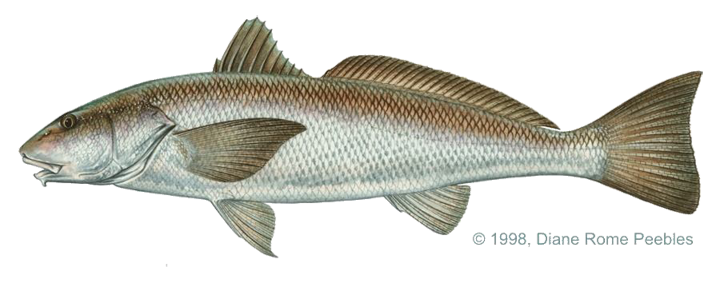Game Fish Identification Reference Guides
Corbina, California
(Menticirrhus undulatus)
(Menticirrhus undulatus)

(Girard 1854); SCIAENIDAE FAMILY; also called California kingcroaker, corvina, California whiting, surffish, sucker
This eastern Pacific species is found from Point Conception in California to Peru. It occurs along sandy shores and in bays, usually in sandy surfs of exposed outer coast. They are usually found in small groups with larger fish becoming more solitary. Unlike most drums and croakers, the California corbina has no air bladder and is unable to make croaking sounds.
The California corbina body is elongate and more slender than other croakers. The head is long and the mouth small with a blunt snout projecting beyond the mouth. The color is gray to steel blue with a silvery luster on the back paling to white below. Sometimes wavy diagonal lines are on the sides. The California corbina and the yellowfin croaker are the only two coastal croakers in California water to have a single short, stiff chin barbel. The California corbina usually has only one weak spine at the front of the anal fin, while the yellowfin croaker has two strong spines.
California corbina are caught throughout the year although the best fishing is from July to October. They are very wary and difficult to hook as many an avid surf fisherman can affirm. Sand crabs are the preferred bait, though some anglers swear by blood worms, mussels, clams, pileworms, and ghost shrimp
This eastern Pacific species is found from Point Conception in California to Peru. It occurs along sandy shores and in bays, usually in sandy surfs of exposed outer coast. They are usually found in small groups with larger fish becoming more solitary. Unlike most drums and croakers, the California corbina has no air bladder and is unable to make croaking sounds.
The California corbina body is elongate and more slender than other croakers. The head is long and the mouth small with a blunt snout projecting beyond the mouth. The color is gray to steel blue with a silvery luster on the back paling to white below. Sometimes wavy diagonal lines are on the sides. The California corbina and the yellowfin croaker are the only two coastal croakers in California water to have a single short, stiff chin barbel. The California corbina usually has only one weak spine at the front of the anal fin, while the yellowfin croaker has two strong spines.
California corbina are caught throughout the year although the best fishing is from July to October. They are very wary and difficult to hook as many an avid surf fisherman can affirm. Sand crabs are the preferred bait, though some anglers swear by blood worms, mussels, clams, pileworms, and ghost shrimp












